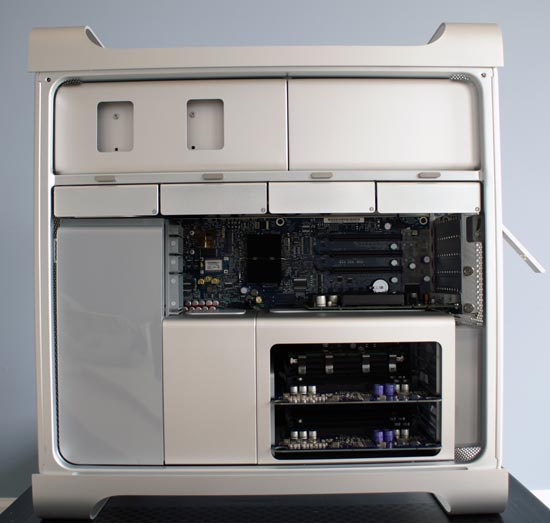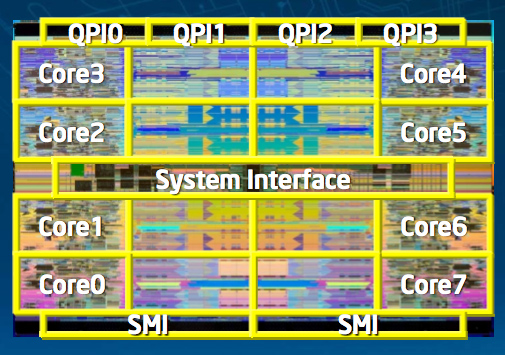Upgrading and Analyzing Apple's Nehalem Mac Pro
by Anand Lal Shimpi on July 13, 2009 5:00 PM EST- Posted in
- Mac
In my line of work, I tend to get access to a lot of very fast hardware. Both our SSD and GPU testbeds use Intel’s new Core i7 processor. If you read my review of the i7 you may have left the review feeling slightly underwhelmed by the processor. Sure, it was fast, but it wasn’t that much faster than a speedy Core 2 Quad.
In the months since that review went live I’ve had the benefit of using the i7 a lot. And I might’ve grown a little attached. The processor itself isn’t overly expensive, it’s the motherboard that really puts it over the top; but if you have the means, I highly recommend picking one up.
This is my Mac Pro:

It may look modern, but this is actually the same Mac Pro I reviewed back in 2006. In it are the same two 3.0GHz dual-core Woodcrest based Xeons that I upgraded it with for part 3 of my Mac Pro coverage. Woodcrest was the server version of Conroe, the heart of the original Core 2 Duo.
You’ll remember that I was quite happy with Conroe when it launched in 2006, so by extension I was quite happy with my Mac Pro. That was then, this is now.
Apple released a newer Mac Pro with quad-core Clovertown parts (65nm Kentsfield equivalent), then once more with Harpertown (45nm Penryn equivalent). While you could stick Clovertown into the first generation Mac Pros, you couldn’t upgrade them to Harpertown without hardware modifications to the system (don’t ask me what they are :)..).
I stayed away from the Harpertown upgrade simply because it was a lot of money for a moderate increase in performance. My desktop tests showed that Penryn generally yielded a 0 - 10% performance increase over Conroe and I wasn’t about to spend $3K for 10%. Steve didn’t need another Benz that badly.
I found myself waiting for Apple to do the right thing and release a Mac based on the Core i7. Surely Apple wouldn’t wait and make a Xeon version, after all why would you need two processors? A single Core i7 can work on eight threads at the same time - most users have a tough time stressing four. Then reality set in: Apple wouldn’t put a Core i7 in the Mac Pro because Dell can do the same in a system for under $900. In order to justify the price point of the Mac Pro, it must use Xeons.
The Nehalem Xeons can be pretty fun. At the high end there’s the Nehalem-EX, that’s 8 cores on a single die. Apple could put two of those on a motherboard and have a 16-core, 32-thread monster that would probably cost over $8,000.

The 8-core Nehalem EX
Getting back to reality, we have the Nehalem-EP processor: effectively a server-version of Core i7. The other major change between Nehalem-EP and Core i7 is that each Nehalem-EP processor has two QPI links instead of one. Nehalem-EP can thus be used in dual-socket motherboards.
Nehalem-EP even uses the same socket as Intel’s Core i7: LGA-1366, implying that Intel artificially restricts its desktop Core i7s to operate in single-socket mode only. Boo.
Of course Nehalem-EP is sold under the Xeon brand; the product names and specs are as follows:
| CPU | Max Sockets | Clock Speed | Cores / Threads | QPI Speed | L3 Cache | Max Turbo (4C/3C/2C/1C) | TDP | Price |
| Intel Xeon W5580 | 2 | 3.20GHz | 4 / 8 | 6.4 GT/s | 8MB | 1/1/1/2 | 130W | $1600 |
| Intel Xeon X5570 | 2 | 2.93GHz | 4 / 8 | 6.4 GT/s | 8MB | 2/2/3/3 | 95W | $1386 |
| Intel Xeon X5560 | 2 | 2.80GHz | 4 / 8 | 6.4 GT/s | 8MB | 2/2/3/3 | 95W | $1172 |
| Intel Xeon X5550 | 2 | 2.66GHz | 4 / 8 | 6.4 GT/s | 8MB | 2/2/3/3 | 95W | $958 |
| Intel Xeon E5540 | 2 | 2.53GHz | 4 / 8 | 5.86 GT/s | 8MB | 1/1/2/2 | 80W | $744 |
| Intel Xeon E5530 | 2 | 2.40GHz | 4 / 8 | 5.86 GT/s | 8MB | 1/1/2/2 | 80W | $530 |
| Intel Xeon E5520 | 2 | 2.26GHz | 4 / 8 | 5.86 GT/s | 8MB | 1/1/2/2 | 80W | $373 |
| Intel Xeon W3570 | 1 | 3.20GHz | 4 / 8 | 6.4 GT/s | 8MB | 1/1/1/2 | 130W | $999 |
| Intel Xeon W3540 | 1 | 2.93GHz | 4 / 8 | 4.8 GT/s | 8MB | 1/1/1/2 | 130W | $562 |
| Intel Xeon W3520 | 1 | 2.66GHz | 4 / 8 | 4.8 GT/s | 8MB | 1/1/1/2 | 130W | $284 |
While Nehalem was originally supposed to have a simultaneous desktop and server/workstation release, the Xeon parts got pushed back due to OEM validation delays from what I heard. Core i7 launched last November and it was now mid-March with no Nehalem based Macs.
I couldn’t wait any longer and I ended up building a Hackintosh based on Intel’s Core i7. Literally a day after I got it up and running, Apple announced the new Nehalem-EP based Mac Pro.










58 Comments
View All Comments
jamesst - Tuesday, July 14, 2009 - link
"The Lexar reader is FireWire 800 (woo!) and the iSight is FireWire 400; I can’t use the iSight on the new Mac Pro."You can still use your Firewire 400 iSight camera on the Mac Pro's Firewire 800 ports. All you need is a Firewire 400 to Firewire 800 cable. I know that Belkin makes just such a cable and I even purchased one at my local Apple Store here in Raleigh, NC.
joelypolly - Monday, July 13, 2009 - link
I have actually had something similar happen to a socket I was working on. It was a matter of finding a sewing needle and moving each "pin" back to the original position.HilbertSpace - Monday, July 13, 2009 - link
It would be interesting to try swapping the 2-socket tray with a 1-socket Mac Pro, and see if it works(?) Would be cheaper to buy the 2-socket board and upgrade yourself, no?MonkeyPaw - Monday, July 13, 2009 - link
Are FB-DIMMs going to disappear from the market? While at first it doesn't sound Mac-related, original MacPro owners might soon be running out of memory upgrade options (though I doubt they've held out this long to upgrade). It wasn't cheap to start with, but it seems like it was Band-Aid technology. The IMC was the answer, but FB-DIMMs were a stop-gap until Nehalem-Xeons could arrive. Perhaps a memorial article for the technology is needed?JimmiG - Monday, July 13, 2009 - link
Ok so I get it, even the "cheap" Mac Pro uses a Xeon, not an i7... But for all intents and purposes, it's an i7 920.Who in their right mind would pay $2,500 for a i7 920 system with 3GB of RAM, 640GB HDD and a rebranded Geforce 9500 GT? You can build a similar PC (or hackintosh) with the same specifications for the a fraction of the price - in fact you could also bump the RAM to 6GB and throw in a 1TB drive and a 4870 1GB or 4890 if you wanted and still stay *well* below that price point, even if using quality components and case.
The Mac Pro isn't even shiny!
plonk420 - Tuesday, July 14, 2009 - link
did you read page 10?MrDiSante - Thursday, July 16, 2009 - link
Did you read his comment?ltcommanderdata - Monday, July 13, 2009 - link
Another great in depth review. Your experiences with upgrading the processors were particularly interesting although I don't think it'd be something I would try.I just wanted to suggest you Boot Camp the Mac Pro and run the benchmarks needed to add 2x2.26GHz Gainestown and 2x2.93GHz Gainestown results to the Anandtech Bench. It might also be interesting to get a sample of the new nVidia GTX285 Mac Edition. It would certainly address the 1GB of VRAM concerns and would be cheaper than getting the HD4870 if you need 2 dual-link DVI ports since you don't need to buy that finicky adapter. There really aught to be DVI to mini-DP adapters though for people who still want to use the 24" LED display.
http://www.glbenchmark.com/result.jsp">http://www.glbenchmark.com/result.jsp
Oh and for interest, there turns out to be a 3D benchmark comparing the various iPhones to other cell phones. It's called GLBenchmark and needless to say, the iPhone 3G S is a screamer. They are also detecting the iPhone 3G S GPU as a PowerVR SGX 535.
ddobrigk - Monday, July 13, 2009 - link
Actually, the Nehalem-EX's octo-core possibility is a no-go for now. It is a future product and has not been launched yet.Also, a little bit of nitpicking, but it won't use LGA1366 like these Xeons, it'll use LGA1567, because each CPU will sport a 4-channel memory controller.
In addition, it'll sport 4 QPI links, and its intended target are 4-way and 8-way systems, not really 2-way systems. A few rumors exist about some integrators being interested in 2-socket systems, though we're still a few months from actually seeing any LGA1567 motherboard on display, AFAIK. All we saw was an Intel Demo about it.
Don't know if Apple intends to go with 2-socket nehalem-exs, anyway, because when Nehalem-EX really hits the market, there'll also be the 6-core westmeres, I think. In any case, we're way beyond a reasonable number of cores for the typical user. :D
BrianMCan - Friday, July 17, 2009 - link
MacPro's really aren't meant for typical users ;)Scientific, Video/Movies, 3D, and advanced users who may do many things including the already mentioned, or many things at once. Always other things I can be doing while some video is rendering, including playing some Civ 4, or starting the next video project, researching upgrades & repairs for customers, stuff like that.
Although I personally may wait for the 2nd gen Nehalem MacPro's before I upgrade from my first gen MacPro, other than raw processing power, it does most of what I need efficiently enough.